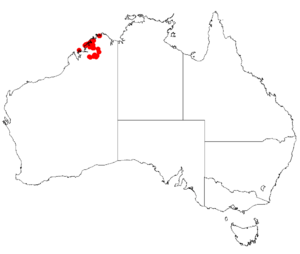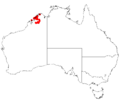Acacia adenogonia facts for kids
Quick facts for kids Acacia adenogonia |
|
|---|---|
| Scientific classification | |
| Genus: |
Acacia
|
| Species: |
adenogonia
|
 |
|
| Where this plant grows in Australia | |
Acacia adenogonia is a type of spiky bush. It belongs to the Acacia family, which is a large group of plants. This particular acacia is special because it only grows in the north-western part of Australia. It's a shrub, which means it's smaller than a tree but bigger than a small plant.
What it Looks Like
This spiky bush usually grows to be about 1 to 2.5 meters (3 to 8 feet) tall. It can grow straight up or spread out wide. Its branches are round and covered in tiny hairs. It has small, leaf-like parts called stipules that stay on the plant for a long time.
Like most Acacia plants, Acacia adenogonia doesn't have regular leaves. Instead, it has flat, leaf-like stems called phyllodes. These phyllodes stay green all year round. They are attached directly to the stem or very close to it. They can stick out or lean, and they are shaped like an uneven oval or a spearhead.
The phyllodes are also hairy and feel leathery. They are about 5 to 10 millimeters long and 1.5 to 4.5 millimeters wide. They get narrower towards a sharp, spiky tip. Each phyllode has three or four veins that are spaced far apart. This plant blooms from May to August and has bright yellow flowers.
How it Got its Name
Scientists give every living thing a special two-part name, like a first and last name. This helps everyone know exactly which plant or animal they are talking about.
Acacia adenogonia was first described by a scientist named Leslie Pedley in 1987. He called it Racosperma adenogonium back then. Later, in 1990, two other scientists, Richard Sumner Cowan and Bruce Maslin, changed its name to Acacia adenogonia. They wrote about it in a science journal called Nuytsia.
Where it Grows
This spiky Acacia is found only in the Kimberley region of Western Australia. It grows in different spots across the West Kimberley area. You can find it along the Bonaparte Archipelago, near Broome and Napiere Bay, and further inland. It grows in places like Phillips Range, Kimberley Downs Station, and Beverley Springs Station.
It likes to grow on sandstone rocks and in sandy soil. It's often found in open woodlands, which are areas with scattered trees and lots of open space.
Images for kids


